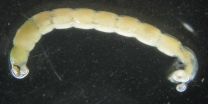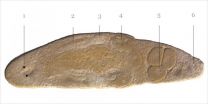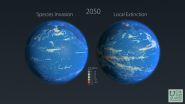INFORMATION:
The work, published in Nature Communications, was done by RIKEN in collaboration with the University of Tokyo, University of Osaka, and was funded by JST and DFG.
Producing spin-entangled electrons
2015-07-01
(Press-News.org) A team from the RIKEN Center for Emergent Matter Science, along with collaborators from several Japanese institutions, have successfully produced pairs of spin-entangled electrons and demonstrated, for the first time, that these electrons remain entangled even when they are separated from one another on a chip. This research could contribute to the creation of futuristic quantum networks operating using quantum teleportation, which could allow information contained in quantum bits--qubits--to be shared between many elements on chip, a key requirement to scale up the power of a quantum computer. The ability to create non-local entangled electron pairs --known as Einstein-Podolsky-Rosen pairs --on demand has long been a dream.
Russell Deacon, who carried out the work, says, "We set out to demonstrate that spin-entangled electrons could be reliably produced. So far, researchers have been successful in creating entangled photons, since photons are extremely stable and do not interact. Electrons, by contrast, are profoundly affected by their environment. We chose to try to show that electrons can be entangled through their spin, a property that is relatively stable."
To perform the feat, Deacon and his collaborators began the painstaking work of creating a tiny device, just a few hundred nanometers in size. The idea was to take a Cooper pair--a pair of electrons that allows electricity to flow freely in superconductors--and get them, while tunneling--a quantum phenomenon--across a junction between two superconductor leads, to pass through two separate "quantum dots"--small crystals that have quantum properties. Deacon says, "If we could detect a superconducting current, this would mean that the electrons, which can be used as quantum bits--the qubits, or bits used in quantum computing--remain entangled even when they have been separated between the quantum dots. We confirm this separation by measuring a superconducting current that develops when they split and are recombined in the second lead."
The quantum dots, each around 100 nanometers in size, were grown at random positions on a semiconductor chip. This chip was painstakingly examined using an atomic force microscope to discover pairs of dots that were close enough that they might function properly. "We observed thousands of dots and identified around a hundred that were suitable. From these we made around twenty devices. Of those just two worked."
By measuring the superconducting current, the team was able to show clearly that the spin of the electrons remained entangled as they passed through the separate quantum dots. "Since we have demonstrated that the electrons remain entangled even when separated," says Deacon, "this means that we could now use a similar, albeit more complex, device to prepare entangled electron pairs to teleport qubit states across a chip."
According to Seigo Tarucha, leader of the laboratory that conducted the work, "This discovery is very exciting, as it could lead eventually to the development of applications such as quantum networks and quantum teleportation. Though it is technically difficult to handle, electron spin is a very promising property for these applications, as it is relatively free from the environment and lasts comparatively long. It could be combined with photons, by using the spin-entangled electrons to create photons that themselves would be entangled. This could allow us to create large networks to share quantum information in a widely distributed way."
ELSE PRESS RELEASES FROM THIS DATE:
Warts and all: How St. John's Wort can make you sick
2015-07-01
St John's Wort can produce the same adverse reactions as antidepressants, and serious side effects can occur when the two are taken together, according to new University of Adelaide research.
In a study published this month in the journal, Clinical and Experimental Pharmacology and Physiology, researchers compared the pattern of spontaneous reported adverse drug reactions to St John's Wort, a herbal treatment for depression, and fluoxetine, a commonly prescribed antidepressant. They found the adverse reactions were the same for people who took St John's Wort as it was ...
Europe, Siberia and in between: Caucasian populations of non-biting midges
2015-07-01
A research in the North Caucasus, conducted by a group of Russian scientists over three years, has revealed an intermediate distribution of Caucasian populations of non-biting midges between Europe and Siberia. Their observations also proved some interesting morphological distinctions between the studied populations and the previously researched ones from Europe and Siberia. Their results have been published in the open-access journal Comparative Cytogenetics.
The study on karyotypical and morphological peculiarities of Ch. bernensis is a part of the investigation of ...
Improving insulation materials, down to wetting crossed fibers
2015-07-01
Sandcastles are a prime example of how adding a small amount of liquid to a granular material changes its characteristics. But understanding the effect of a liquid wetting randomly oriented fibres in a fibrous medium remains a mystery. Relevant to the building industry, which uses glass wool, for instance, this phenomenon can be better understood by studying the behaviour of a liquid trapped between two parallel fibres. It can either remain in the shape of a drop or spread between the fibres into a long and thin column of liquid. Now, scientists have demonstrated that the ...
The bizarre mating habits of flatworms
2015-07-01
Failing to find a mating partner is a dent to the reproductive prospects of any animal, but in the flatworm species Macrostomum hystrix it might involve a real headache. Zoologists from the Universities of Basel and Bielefeld have discovered the extraordinary lengths to which this animal is willing to go in order to reproduce - including apparently injecting sperm directly into their own heads. The academic journal Proceedings of the Royal Society B has published their findings.
The absence of a mate usually spells disaster for sexually reproducing animals. However, some ...
Clues to inner atomic life from subtle light-emission shifts
2015-07-01
Atoms absorb and emit light of various wavelengths. Physicists have long known that there are some tiny changes, or shifts, in the light that gets absorbed or emitted, due to the properties of the atomic nucleus. Now, a team of scientists has elucidated the so-called hyperfine structure of cadmium atoms. Relying on a method called laser spectroscopy, they have measured variations in the energy transition within cadmium atom - Cd in the periodic table. They studied a chain of isotopes with an odd number of neutrons ranging from 59 in 107Cd to 75 in 123Cd. From these high-precision ...
Sleep deprivation could reduce intrusive memories of traumatic scenes
2015-07-01
A good night's sleep has long been recommended to those who have experienced a traumatic event. But an Oxford University-led study provides preliminary experimental work suggesting it could actually be the wrong thing to do.
The research, conducted in Oxford's Wellcome Trust-funded Sleep and Circadian Neuroscience Institute (SCNi) and published in the journal Sleep, showed that sleep deprivation might prevent people from consolidating memories of experimental trauma (emotional film clips in the study), reducing their tendency to experience flashbacks.
Dr Kate Porcheret, ...
Level I trauma experience prepares surgeons for battle
2015-07-01
(SACRAMENTO, Calif.) -- Soldiers injured during the conflicts in Iraq and Afghanistan have the highest survival rates in history, thanks to the availability of surgeons skilled in combat care. But combat-ready surgical skills are hard to sustain off the battlefield.
"A lot of knowledge builds up in the military medical enterprise during times of war," said Joseph Galante, who chairs the UC Davis Division of Trauma, Emergency and Critical Care Surgery and is a commander in the U.S. Navy Reserves. "When peacetime comes, that knowledge can slide. We need to identify ways ...
Seafood supply altered by climate change
2015-07-01
The global supply of seafood is set to change substantially and many people will not be able to enjoy the same quantity and dishes in the future due to climate change and ocean acidification, according to UBC scientists.
These findings were released today in Japan by the Nereus program, an international research team led by UBC scientists and supported by the Nippon Foundation. The Nereus program was formed to study the future of the world's oceans and seafood resources. Today it released a summary of the first phase of its research in a report titled 'Predicting Future ...
Citrus fruit consumption may be associated with increased melanoma risk
2015-07-01
ASCO Perspective: Gary Schwartz, MD, ASCO Expert "This study adds to the growing discussion around food and cancer risk. While the findings are intriguing, it's far too soon to recommend any broad changes to grapefruit or orange consumption. Until conclusive data are available, we should continue to be cautious about protecting our skin from sun exposure."
A new analysis of dietary patterns among more than 100,000 Americans suggests that frequent consumption of citrus -- namely whole grapefruit and orange juice -- may be associated with an increased risk of melanoma. ...
Live imaging reveals how wound healing influences cancer
2015-07-01
July 1 -- Researchers in the United Kingdom and Denmark have studied the "see-through" larvae of zebrafish to reveal how wound healing leads to skin cancer. Live imaging shows neutrophils, the protective inflammatory cells of the body's immune system, diverted from an induced wound to any nearby precancerous skin cells. The newly arrived neutrophils cause rapid division of these skin cells, which may cause them to progress to melanoma. The results are published in The EMBO Journal.
"Our results provide direct visual evidence of a physical link between wound-associated ...



